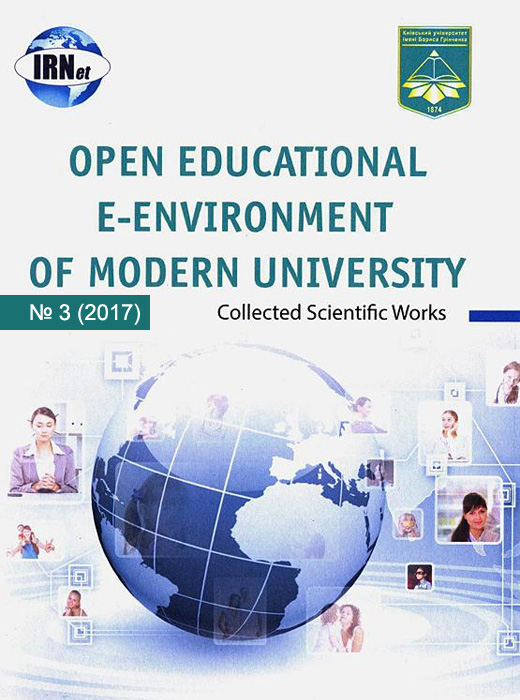BLENDED AND DISTANCE LEARNING AS A WAY OF ACCESS TO QUALITY EDUCATION
DOI:
https://doi.org/10.28925/2414-0325.2017.3.28387Keywords:
ICT, Mixed learning, Distance Learning, independent work, Distance courses, Education statisticsAbstract
The article deals with the terminology of mixed and distance learning, the theory and method of distance learning, which should take into account the changes that have taken place in the educational information structure of modern society, which determines the relevance of the development and implementation of new educational services based on ICT and remote technologies. Distance education today is especially relevant in the field of training young people with a different age, cultural, social level and different motives of education. Distance learning can be considered as a means of modernizing the education system. The structure of online and full-time learning forms, trends in the implementation of a mixed form of learning is analyzed.
Downloads
References
Биков В.Ю., Кухаренко В.М., Сиротенко Н.Г., Рибалко О.В., Богачков Ю.М. Технологія розробки дистанційного курсу. За ред. Бикова В.Ю. та Кухаренка В.М. Київ. Міленіум. 2008. 324 с.
Болюбаш Н. М. Використання сучасних інформаційних технологій у професійній підготовці економістів [Електронний ресурс]. Інформаційні технології і засоби навчання. 2009. № 5 (13). URL: http://www.nbuv.gov.ua/e-journals/ITZN/em13/ content/09bnmetv.htm
Гуманитарные технологии. Информационно-аналитический портал [Електронный ресурс]. URL: http://gtmarket.ru/
Каташинская А. Украина – среди стран-лидеров по общей образованности. - Комсомольская правда Украины (2016) [Електронний ресурс]. URL: http://kp.ua/life/534000-ukrayna-sredy-stran-lyderov-po-obschei-obrazovannosty.
Коваль М. В. Електронне дистанційне і комбіноване навчання у львівських вищих освітніх закладах. Педагогіка і психологія професійної освіти. 2006. № 1. C. 199 203.
Кухаренко В.М., Березенська С.М., Бугайчук К.Л., Олійник Н.Ю., Олійник Т.О., Рибалко О.В., Сиротенко Н.Г., Столяревська А.Л. Теорія та практика змішаного навчання: Монографія (2016) [Електронний ресурс]. URL: http://repository.kpi.kharkov.ua/bitstream/KhPIPress/23536/3/Kukharenko_Teoriia_ta_praktyka_2016.pdf
Подберезкина А. Blended Learning: переход к смешанному обучению за 5 шагов [Електронний ресурс]. URL: http://zillion.net/ru/blog/375/blended-learning-pieriekhod-k-smieshannomu-obuchieniiu-za-5-shaghov
Рашевська Н. В. Програмні засоби мобільного навчання [Електронний ресурс]. Інформаційні технології і засоби навчання. 2011. № 1 (21). URL: http://www.nbuv.gov.ua/e-journals/ITZN/2011_1/Rashevska.pdf
Смирнова-Трибульская Е. Н. Основы формирования информатических компетентностей учителей в области дистанционного обучения: монография / Е. Н. Смирнова- Трибульская. Министерство образования и науки Украины: Национальный педагогический университет имени М.П. Драгоманова. Херсон: Айлант. 2007. 704 с.
Collis B., Moonen J. Flexible learning in a digital world: experiences and expectations. London: Kogan Page Limited. 2001. 231 p.
Patricia Mc Gee, Abby Reis. Blended Course Design: A Synthesis Of Best Practices. Journal of Asynchronous Learning Networks. 2012. Volume 16. Issue 4. p.7- 22.
Blended Learning Systems: Definition, Current Trends, And Future Directions [Online]. URL: http://oldwww.sd91.bc.ca/frenchj/My%20Pages/e-articles/graham_intro.pdf
REFERENCES (TRANSLATED AND TRANSLITERATED)
Bykov, V.Ju., Kukharenko, V.M., Syrotenko, N.Gh., Rybalko, O.V. & Boghachkov, Ju.M. (2008). Technology development distance course, Kyiv, Milenium, 324 p. (in Ukrainian)
Boljubash, N. M. (2009). The use of modern information technologies in the training of economists. Іnformacіjnі tehnologії і zasobi navchannja, 5 (13). Retrieved from http://www.nbuv.gov.ua/e-journals/ITZN/em13/content/09bnmetv.htm (in Ukrainian)
Katashinskaja, A. (2016) Ukraine among the countries-leaders by global education. Komsomol'skaja pravda Ukrainy. Retrieved from: http://kp.ua/life/534000-ukrayna-sredy-stran-lyderov-po-obschei-obrazovannosty (Russian)
Kovalj, M. V. (2006). Electronic distance and combined studies in Lviv higher education institutions. Pedagogy and Psychology of Professional Education, 1, 199-203 (in Ukrainian)
Kukharenko, V.M., Berezensjka, S.M., Bughajchuk, K.L., Olijnyk, N.Ju., Olijnyk, T.O., Rybalko, O.V., Syrotenko, N.Gh. & Stoljarevsjka, A.L. (2016) Teorija ta praktyka zmishanogho navchannja: Monoghrafija (2016). Retrieved from: http://repository.kpi.kharkov.ua/bitstream/KhPI-Press/23536/3/Kukharenko_Teoriia_ ta_praktyka_2016.pdf (in Ukrainian)
Podberezkina, A. (2013). Blended Learning: transition to mixed learning in 5 steps Retrieved from: http://zillion.net/ru/blog/375/blended-learning-pieriekhod-k-smieshannomu-obuchieniiu-za-5-shaghov (in Russian)
Rashevs'ka, N. V. (2011). Software for mobile mobility. Іnformacіjnі tehnologії і zasobi navchannja, 1 (21). Retrieved from: http://www.nbuv.gov.ua/e-journals/ITZN/2011_1/Rashevska.pdf (in Ukrainian)
Smirnova-Tribul'skaja, E. N. (2007). Fundamentals of the formation of informational competence of teachers in the field of distance learning: monograph. Ministry of Education and Science of Ukraine: Nacional'nyj pedagogicheskij universitet imeni M.P. Dragomanova. Herson: Ajlant, 704 p. (in Russian)
Collis, B. & Moonen, J. (2001). Flexible learning in a digital world: experiences and expectations. London: Kogan Page Limited, 231 p.
Patricia, Mc Gee, Abby, Reis (2012). Blended Course Design: A Synthesis Of Best Practices. Journal of Asynchronous Learning Networks, Volume 16: Issue 4, p.7-22
Blended Learning Systems: Definition, Current Trends, And Future Directions (2004). Retrieved from: http://oldwww.sd91.bc.ca/frenchj/My%20Pages/e-articles/graham_intro.pdf













1.jpg)








